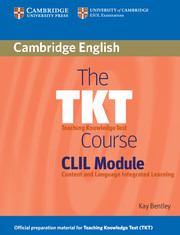Unit 14 - Consolidating learning and differentiation
Published online by Cambridge University Press: 27 September 2023
Summary
Why are consolidating and differentiating learning important in CLIL?
In all learning, we need to give learners time to consolidate or strengthen what they have already learned. In CLIL contexts this is particularly important as learners are processing new content knowledge in a non-native language. Consolidating learning is not simply revisiting content and language the next day or the next week. It means learners should activate what they have learned previously so they can improve their skills. To consolidate and improve their skills, many learners need to revisit learning again and again by doing a variety of different tasks.
When we have learners who are more able or less able than others in the class, we need to differentiate teaching and learning as these learners have different needs. We need to address these learners’ needs and strengths by giving strategies for learning, and sometimes strategies to help them socially as well. Differentiation is particularly important in CLIL because learners’ language skills may be at a different stage of development from their subject skills. Some learners may be excellent mathematicians but find reading maths problems hard. Other learners may have high language levels but find understanding scientific concepts in a non-native language very challenging.
Key concepts
How can we consolidate learning?
Monitoring
We need to observe learners to see when they have difficulties with new learning. The difficulty of a task could be because learners have a lack of subject knowledge, a lack of language knowledge or they don't understand the concepts. It could also be because they don't have enough support to complete the task. When we see a group of learners who don't understand, we may need to remind learners of key content knowledge, use examples of learners’ work to show effective models or take time to explain to learners why answers are not correct. We may also need to demonstrate parts of a lesson again.
Reviewing
Learners need to review their work so they can consolidate and deepen their understanding of content knowledge.
- Type
- Chapter
- Information
- The TKT Course CLIL Module , pp. 79 - 83Publisher: Cambridge University PressPrint publication year: 2010



